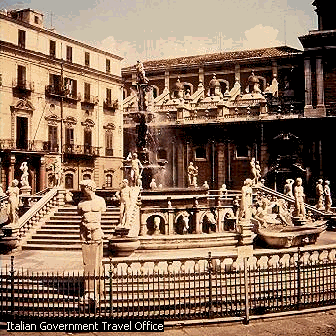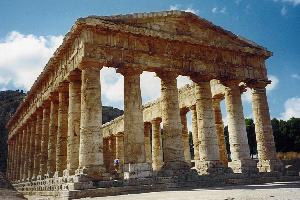|
Sicilian Rule and Lifestyle
- 30BC to 30AD
|
Abstract

Sicilian lifestyle from 30BC to 30AD, also known as part of the Middle
Roman Era, consisted of agriculture, poverty, enslavement, taxation and
violence. Wealthy magnates, both native and immigrant, ruled the
island under Roman supervision. The Romans considered Sicily a province
and agricultural mainstay. Fertile volcanic land gave it an agricultural
advantage. Much of the grain used by the Empire to feed soldiers
and citizens came from this island. Greek, Latin and indigenous provincial
languages created a unique dialect, although Greek dominated linguistically
during this period of Sicilian history. Ethnically, Sicilians
of the Middle Roman Era claimed Sicel (an indigenous people of unknown
origin), Greek, Phoenician and Carthaginian ancestry.
Historical
Background
The geographic location of Sicily, between Italy and Northern Africa,
not only linked these two areas by narrow channels, but also served as
a nautical center between Eastern and Western Mediterranean societies.
Greek emigration, specifically from Corinth, established Hellenistic city-state
communities, Syracuse was the first of these Greek communities. Their
architecture,
philosophy, culture dominated Eastern coast of Sicily (~730BC).
Phoenician emigration soon followed and because of the already established
Greek city-states along the Eastern coast, they were forced to settle the
Western side of the island (~700BC) at Panormos (Palermo). The next
three hundred years saw an influx of Greeks, Phoenicians and Carthaginians,
but not continual peace or social equality for the native Sicilians.
Land and slaves were the most valued commodities in Sicily at this time.
Immigrants and freeborn natives wanted as much of these two “resources”
as possible and fought historic battles for this strategic, agriculturally
productive Mediterranean island. Cultural stagnation accompanied
these conflagrations. The first of these battles occurred in 550BC when
a Carthaginian General named Mago defeated the immigrant Greeks and began
a dynasty that lasted for over one hundred fifty years. After this
period of relative tranquility, other battles (Himera, Syracuse, Selinus
and Motoya) occurred along with two major slave revolts. These battles
and uprisings peaked when Hannibal Barca (of Carthage) started the Punic
Wars. His eventual loss left Rome in control of Sicily through 440AD.
Research
Report
Sextus Pompey, a Roman soldier and sailor based in Spain, highlighted
the importance of Sicily to Rome by sailing his fleet from Spain to the
Straits of Messina (44BC). By creating a tactical blockade, he prevented
Sicilian grain from reaching Italy. This immediately presented problems
for the Triumvirate government recently plunged into chaos with the assassination
of Julius Caesar. In exchange for rule over Sicily, Sardinia and
Corsica, he lifted the blockade. This situation, used immediately as an
advantage by Octavian-Augustus to move against Pompey, resulted in the
destruction of Pompey’s fleet, elimination of all troops and native Sicilians
that assisted him. Octavian-Augustus ordered the capture and execution
of Pompey.
 Following the
battles at Actium and against Sextus Pompey, Octavian-Augustus controlled
many of the Sicilian estates. This was due in large part to the loss
of owners and slaves conscripted and killed while serving in the Roman
legions. Consequently, his confiscated lands went unattended until
he decided to distribute it to returning loyal Roman veteran-citizens who
also served the purpose of repopulating the island. Unfortunately,
those natives that didn’t fight with the legions and stayed back to continue
farming did not automatically receive the coveted Roman citizenship.
Following the
battles at Actium and against Sextus Pompey, Octavian-Augustus controlled
many of the Sicilian estates. This was due in large part to the loss
of owners and slaves conscripted and killed while serving in the Roman
legions. Consequently, his confiscated lands went unattended until
he decided to distribute it to returning loyal Roman veteran-citizens who
also served the purpose of repopulating the island. Unfortunately,
those natives that didn’t fight with the legions and stayed back to continue
farming did not automatically receive the coveted Roman citizenship.
Unless a native Sicilian qualified for residency in one of newly
designated cities known as a Coloniae, or a Municipa, he did not qualify
for Roman citizenship. The difference between the two designations
is that a Coloniae’s population consisted of honored veterans and a Muncipa’s
population consisted of citizens that received a reward for some type of
service. Six Coloniaes (Tauromeium, Catania, Syracuse, Tyndaris,
Palermo and Thermae) and two Municipas (Messina and Lipari) existed during
this time. Of course, Roman citizens lived all over the island, yet
these designated cities followed Roman laws, customs, courtesies and provided
opportunities for its citizens to qualify for Roman Offices. The
others cities were free to govern themselves as they pleased. Taxation
was, however, a sticking point.
All Sicilians, regardless of material wealth or social status paid tax
to Rome. This occurred in all Roman controlled countries outside
of Italy. Because Sicily served only one purpose in the eyes of the
Rome - the most productive grain-producing province in the empire, wealthy
landowners paid hefty taxes on their holdings. Other Roman provinces
began producing crops, diminishing Sicily’s agricultural reputation for
a time. This kept the “freed” slaves tied to a landowner to which
they looked to for subsistence and wages. Both forms of payment almost
never satisfied native Sicilian farmers. Poverty, not prosperity
continued during this period. Philanthropists became more important in
the lives of native Sicilians as they purchased food and other sundry items
for them.
With the return of Roman military veterans and merchant traders came
Latin and its dialects. Greek was the common language spoken in Sicily
during this period. However, regional dialects combining Phoenician,
Latin, Sicel and Carthaginian were just as common. Regional dialects
became the mode of recognition among the native Sicilian population.
As the native population is best described as an amalgamation of various
Mediterranean peoples, so too became the dialect that developed during
this period. Ethnicity also played a role in Middle Roman Era Sicily.
The primary root races of Sicily are Sicel (an indigenous people of
unknown origin), Greek, Phoenician and Carthaginian. Their respective
dialects differentiated one Sicilian from another. A stronger Greek
influence in the eastern portion of the island resulted in a lighter complexions
and stronger knowledge of Greek tradition and culture. The Sicilians
of Phoenician and Carthaginian descent had darker complexions and a more
Mediterranean-like appearance. These regional ethnic variations effected
everything from food preparation to sub-culture mentality. The common
denominator among those that worked the land was the poor to mediocre conditions
they endured as one of Rome’s most valuable assets - farmers.
Historical
Significance
Peace and stability occur when a government provides protection from
invasion for its people. This period of Sicilian history demonstrates
this stability as it was provincially tied to Rome while its culture, prosperity
and scientific advancement flourished. However, another facet of
this period is that quality of life improves for those that take steps
to climb the social ladder
within their respective countries. Fortunately, there are many
ways for individuals living in modern western civilization to elevate themselves
from one level to another via education, employment and other modes of
advancement. Sicilians in the Middle Roman Era, unable to socially
advance, demonstrated a sense of community along with other personal, intangible
traits such as motivation, endurance and courage. Their daily life
demanded this. It is common theme in many cultures and continues
to influence western civilization today.
References
Miller, Helen H Sicily and the Western Colonies of Greece.
New York: St. Martin’s Press, 1965.
Finley, M. I. A History of Sicily. New York:
Free Press, 1968.
Pereira, Anthony. Sicily. New York: Free Press,1972.
James, Simon. Ancient Rome. Chicago, 1990.
Brea, L. Bernarbo. Sicily Before The Greeks.
New York: St. Martin’s Press, 1966.
Web Resources
Punic
War Era Timeline
The
Revision of Ancient History - A Perspective
Web
Sites of Italian Interest
Siculus
Diodorus - Roman Historian
Italian
Cultural Institute - San Francisco
 Following the
battles at Actium and against Sextus Pompey, Octavian-Augustus controlled
many of the Sicilian estates. This was due in large part to the loss
of owners and slaves conscripted and killed while serving in the Roman
legions. Consequently, his confiscated lands went unattended until
he decided to distribute it to returning loyal Roman veteran-citizens who
also served the purpose of repopulating the island. Unfortunately,
those natives that didn’t fight with the legions and stayed back to continue
farming did not automatically receive the coveted Roman citizenship.
Following the
battles at Actium and against Sextus Pompey, Octavian-Augustus controlled
many of the Sicilian estates. This was due in large part to the loss
of owners and slaves conscripted and killed while serving in the Roman
legions. Consequently, his confiscated lands went unattended until
he decided to distribute it to returning loyal Roman veteran-citizens who
also served the purpose of repopulating the island. Unfortunately,
those natives that didn’t fight with the legions and stayed back to continue
farming did not automatically receive the coveted Roman citizenship.
